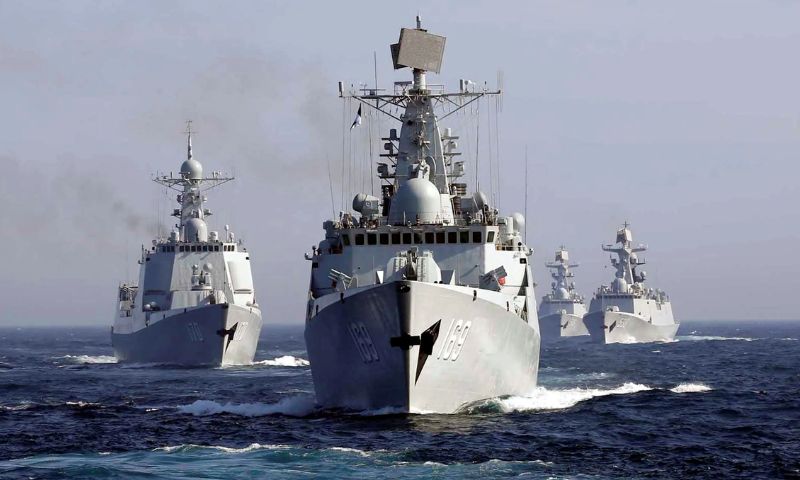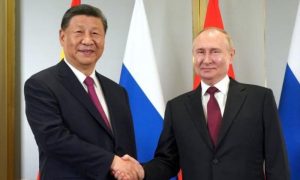BEIJING: In a display of unwavering military collaboration between two global powerhouses, China has graciously played host to two illustrious Russian warships that recently charted a course past the contested waters of Taiwan and Japan.
The Gromkiy and Sovershenniy frigates, esteemed members of Russia’s formidable Pacific Fleet stationed in the thriving metropolis of Vladivostok, gracefully made port at the financial epicentre of Shanghai on a momentous Wednesday, as announced by Chinese state television.
During their anticipated seven-day sojourn, these nautical behemoths are poised to embark on a synergistic voyage of joint drills, aligning their naval prowess with the esteemed Chinese navy. The forthcoming exercises, set to take place amidst Shanghai’s maritime splendour, are meticulously designed to hone the art of formation movements, bolster seamless communication, and refine the intricacies of sea rescues—an unequivocal testament to the indomitable spirit of camaraderie shared between these maritime giants.
Eagerly poised to navigate the vast expanse of the East China Sea, the Russian frigates, with unwavering determination, seek to traverse the pristine waters, intertwined with their Chinese counterparts, fostering an atmosphere of mutual understanding and collaboration. As maritime enthusiasts and military aficionados eagerly anticipate this remarkable spectacle, the joint drills are poised to epitomize the harmonious synergy achieved when great powers unite.
The significance of this momentous occasion extends far beyond the glittering Shanghai skyline. It represents a tangible manifestation of the robust geopolitical bond that binds China and Russia, a formidable alliance that has withstood the test of time. Undoubtedly, these joint naval exercises will undoubtedly serve as an enduring testament to the ironclad friendship between the two nations, forged through shared strategic interests and unwavering resolve.
As the drums of diplomacy beat rhythmically across the vast expanse of the Pacific, China and Russia stand resolute, showcasing their unwavering commitment to maintaining peace and stability within the region. It is within the vessel-laden embrace of Shanghai’s picturesque harbour that these two maritime juggernauts will transcend national boundaries, skillfully navigating the complexities of naval manoeuvres and orchestrating a spectacle that epitomizes their steadfast dedication to safeguarding the maritime domain.
Beyond the shimmering surface of these meticulously planned drills, a myriad of implications can be discerned. The joint display of naval might serves as a profound reminder to the international community of the burgeoning multipolar world, where the strategic balance of power continually evolves. This showcase of unity, resonating with echoes of unwavering cooperation, imparts a message that resonates beyond the waves of the East China Sea—a clarion call to nations far and wide that geopolitical alliances will invariably shape the contours of tomorrow’s global landscape.
As the seven-day sojourn commences, the world watches with bated breath, captivated by the spectacle unfolding amidst the gentle lapping of the waves. Through the convergence of their maritime forces,
China and Russia stand poised to etch yet another chapter in their rich history of diplomatic collaboration—a testament to the unyielding resolve of two great nations, forever tethered by their shared vision for a peaceful and prosperous future.
The convergence of the Gromkiy and Sovershenniy in Shanghai’s embrace stands as a resplendent beacon, shining a light on the multifaceted dimensions of Sino-Russian relations. The undulating ebb and flow of these majestic vessels, as they engage in intricate naval drills, signifies the symphony of cooperation that reverberates across the waters—a symphony that resonates with diplomatic precision, harmonizing the interests of two stalwarts in the contemporary geopolitical theatre.
In this maritime ballet, China and Russia intertwine their Destin.
Russian Naval Fleet’s Passage Raises Regional Tensions
In a display of their growing military partnership, Russian naval vessels from the Pacific fleet recently traversed the waters adjacent to Taiwan, a democratically governed island nation, and sailed past Japan’s Okinawa islands, where a crucial U.S. military base is situated. This provocative passage has triggered concerns among regional powers, leading Japan to dispatch its own vessels to monitor the Russian fleet’s movements. Simultaneously, Taiwan, which China claims as part of its own territory, swiftly deployed aircraft and ships to closely observe the Russian naval transit.
This latest manoeuvre comes in the wake of Chinese President Xi Jinping‘s visit to Moscow in March, during which he engaged in talks with Russian President Vladimir Putin. Their joint statement, issued upon the conclusion of the meeting, bore familiar allegations against the West, accusing Washington of undermining global stability and NATO of encroaching upon the Asia-Pacific region.
Evidently, China and Russia have pledged to strengthen their military ties, as exemplified by China’s Defense Minister Li Shangfu’s recent meeting with the head of the Russian Navy, Admiral Nikolai Yevmenov, in Beijing. Furthermore, both nations’ foreign ministries conducted consultations on anti-missile defence at the end of June, underscoring the depth of their strategic cooperation.
Adding another layer to their burgeoning alliance, the chief of China Central Military Commission’s joint staff department, Liu Zhenli, engaged in discussions via video link with Russia’s chief of general staff, Valery Gerasimov, just last month. These high-level military talks signify the intensifying collaboration between China and Russia in the defence arena, setting a disconcerting precedent for neighbouring countries and heightening regional tensions.
The passage of Russian naval vessels through sensitive waters near Taiwan and Japan serves as a stark reminder of the complex geopolitical dynamics unfolding in the Asia-Pacific region. As China continues to assert its influence and challenge the existing international order, its military partnership with Russia injects an additional element of uncertainty. The close coordination and joint statements made by the two leaders during President Xi’s visit to Moscow indicate a shared perspective on countering Western influence and bolstering their respective positions.
For Taiwan, the transit of Russian warships near its shores poses a direct challenge to its sovereignty. China’s ongoing claims over Taiwan’s territory, coupled with the display of military strength by Russia, magnify the island’s vulnerability and the need for steadfast international support.
Similarly, Japan finds itself directly affected by the presence of Russian naval vessels in the vicinity of its Okinawa islands, which house a critical U.S. military base. This display of force underscores the complex security environment in the region and raises questions about the balance of power.
As China and Russia tighten their military bonds, neighbouring countries must grapple with the implications of this deepening partnership. The passage of the Russian fleet near Taiwan and Japan serves as a stark warning, demanding a strategic response to safeguard regional stability and uphold the principles of international law.
In conclusion, the recent transit of Russian naval vessels near Taiwan and Japan has heightened tensions in the Asia-Pacific region. China and Russia’s expanding military ties, exemplified by high-level meetings and joint statements, underscore their shared objectives and the challenges they pose to regional security. As the global balance of power continues to evolve, it becomes imperative for affected nations to carefully assess the geopolitical landscape and adopt a proactive stance to ensure the preservation of peace and stability in the region.


























